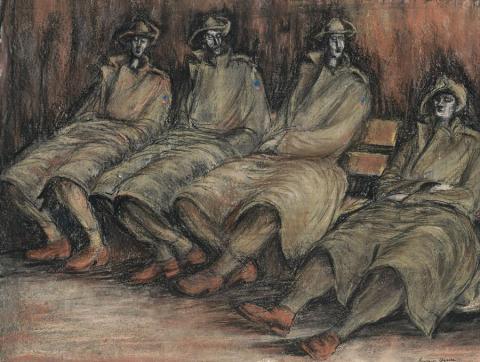SOLDIERS, ALBURY STATION, 1942
Russell Drysdale
pastel on paper
31.5 x 42.0 cm
signed lower right: Russell Drysdale
Deutscher Fine Art, Melbourne, 1995
The Hicks Family Collection, Melbourne
Australian Art: Colonial to Contemporary, Deutscher Fine Art, Melbourne, May - June 1995, cat. 67, (illus.) Australian War Memorial, Canberra (label attached verso)
Klepac, L., The Life and Work of Russell Drysdale, Bay Books, Sydney, 1983, p. 221, pl. 33 (illus.) & p. 366, cat. 33 as ‘whereabouts unknown’
Russell Drysdale was an outstanding draughtsman. His great ability to draw figures created a gallery of special characters - stockmen, women and children, in the outback or in the pub, Aboriginal and white - that are as Australian as Uluru.1 His drawings of soldiers have a special place in that gallery, no better summed up than in the pen and ink drawings, Soldier with Three Children 1941, in the collection of the National Gallery of Victoria, and Standing Soldier in John Hetherington's 1943 book Australian Soldier: A Portrait. The Second World War entered Drysdale's art through such works and especially through a series of drawings, watercolours and oils based on his experiences in Albury. It was this same year of 1942 that one of the world's most distinguished art museums, the Metropolitan Museum of Art, New York bought his painting, Monday Morning, 1938, such prestigious international recognition outstripping that by any Australian public gallery.2
Drysdale was not accepted for military service because of his impaired eyesight. When the Drysdale family moved to Albury for six months in 1942, however, they were surrounded by soldiers from the several military camps nearby - and especially the congregations at the Albury railway station, always crowded with troops waiting for the trains. In those days the railway gauges of Victoria and New South Wales were different. All passengers and freight had to change at Albury. The wait was often long with soldiers sleeping wherever they could, as in Soldiers, Albury Station. The attraction of the wartime station and its crowds was such that it took on the significance of a theme in Drysdale's art. A number of related drawings and paintings include two gouache and ink versions of Albury Platform, 1943, one being in the collection of the Albury Regional Arts Centre. The wartime ‘brownout’ added to the sepulchral feel of many of these works, aided by Drysdale's use of a limited palette, the flicker of painted light, and the textured, sculptural handling of the figures. Drysdale had been influenced by the drawings of the British sculptor Henry Moore, which he had seen in London in 1939.3 Added stimulus was given by the illustration in the September 1941 issue of Art and Australia of several of Moore's drawings of people sleeping in the London underground, tomb-like figures in their make-shift air raid shelters.4 This enhancing influence is apparent in the sprawling, laconic figures of Soldiers, Albury Station, especially in the way in which Drysdale sought to suggest form by highlighting the sense of the body beneath the heavy trench coats. To this he added three masterly Drysdale characteristics - objectivity, stoicism and silence.
1. Drysdale's drawings are held in such high regard that two major exhibitions were devoted to them during his own lifetime. The Drawings of Russell Drysdale, 1980 Perth Survey of Drawing, as part of the Festival of Perth, Art Gallery of Western Australia, touring to the State Galleries in Sydney, Brisbane and Adelaide. Russell Drysdale Drawings 1935 - 1980, Joseph Brown Gallery, Melbourne, 1981 - over 100 drawings from the artist's ‘portfolio’.
2. The Art Gallery of New South Wales purchased its first Drysdale in 1942, the same year as the National Gallery of Victoria acquired Moody's Pub, 1941. The Art Gallery of South Australia's first Drysdale was Local V.D.C. Parade 1943 purchased in 1944
3. Exhibition of Drawings for Sculpture, Mayor Gallery, London
4. Read, H., ‘The Drawings of Henry Moore’, Art and Australia, Sydney, September 1941, pp. 10 - 18
DAVID THOMAS
